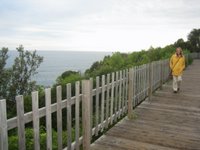This is the action we saw this past weekend at Lorne for the surf rescue part of Rescue 06, the world lifesaving championships hosted this year by Geelong and area. As expected, Australia and New Zealand cleaned up in this portion!
These photos are from the flag race finals where one person is eliminated each round.

This is the ready position in the final round--between a Kiwi and a Japanese. The competitors have to jump up and turn around.

Then they race across the sand . . .
 . . . and dive for the plastic stick thing. This photo is from the previous round where Australia got eliminated but it just shows you how brutal it can be at the end! The Kiwi triumphed and the Japanese second place finisher broke into tears (overcome by getting second place or losing first place, we're not sure).
. . . and dive for the plastic stick thing. This photo is from the previous round where Australia got eliminated but it just shows you how brutal it can be at the end! The Kiwi triumphed and the Japanese second place finisher broke into tears (overcome by getting second place or losing first place, we're not sure). Here we have the boys ready for the swim competition--the Team Canada competitor is the one with the solid red cap. There were lots of speedos on display but that's clearly not a fashion faux pas when dealing with world champion lifeguards.
Here we have the boys ready for the swim competition--the Team Canada competitor is the one with the solid red cap. There were lots of speedos on display but that's clearly not a fashion faux pas when dealing with world champion lifeguards. And finally, the champion taplin relay (swim, board, kayak, race) team: the Kiwis perform a haka, derived from a traditional Maori celebration (or war) dance. This is the dance where they stick out their tongue.
And finally, the champion taplin relay (swim, board, kayak, race) team: the Kiwis perform a haka, derived from a traditional Maori celebration (or war) dance. This is the dance where they stick out their tongue.












